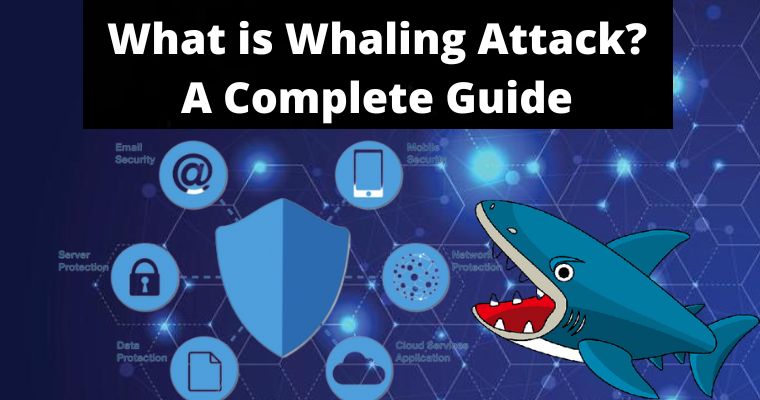Till now, you must have heard about many cyber-attacks, but you have hardly heard about the attack that we are going to tell you about today.
Today we are going to talk about the whaling attack. A whaling attack is a type of phishing scam and CEO fraud. The main objective is to target high-profile executives with access to highly valuable information.
During a whaling attack, hackers utilize social engineering to reveal users’ bank account data, employee personnel details, client information or credit card numbers, or even those who are business CEOs or CFOs. , also referred to as wire transfer.
Whale phishing is usually more difficult to detect than standard phishing attacks, as these attacks frequently do not use malicious URLs or unbreakable attachments.
Whale attacks can happen swiftly but are frequently carried out over the course of weeks or months. When a senior user interacts with an attacker, the attacker aims to set up an authentic trust of the target.
Moving the attack to the next stage too quickly can leave the target doubtful. But, if the attacker slowly proves that they are who they claim to be, there might be no problem with handing over sensitive information to the target.
Table of Contents
What is Whaling in Cybersecurity?
Whaling is a general cyber attack that happens when an attacker utilizes a spear-phishing process to go after a large, high-profile target, such as the c-suite.
Malicious actors recognize that executives & high-level employees (like public spokespersons) can be savvy to the standard roster of spam tactics;
They might have received extensive security knowledge training because of their public profile, and the security team might have more stringent policies & heftier tools in place to defend them.
This leads attackers who try to phish these targets to look beyond the same old tried-and-true tactics to more refined, targeted methods.
Well, whaling is different from fraud-phishing in that the fraudulent communications have come from a senior.
These attacks can be made more convincing when cybercriminals utilize critical research that uses openly available resources such as social media to make a bespoke approach tailored to those target individuals.
Executives must also learn to take special care when posting & sharing information online on social media sites such as Facebook, Twitter & LinkedIn.
Details such as hobbies, birthdays, job titles, holidays, promotions, and relationships can be used by cybercriminals to craft more refined attacks.
Here are the Types of Some Whaling Scams
Whaling attacks can be intended to accomplish a variety of goals. Some ordinary examples of whaling scams include:
- Data Exposure: Whaling attacks can be designed to steal responsive information about an organization, its workers, or its clientele.
- We tell you about one such cyber attack. As a result of an attack against Seagate, the company’s 10,000 employees’ W2 forms were exposed, which could be used for identity theft and other fraud.
- Financial Theft: Whaling emails usually use false unpaid invoices and other pretexts to steal funds from a company. An attack against FACC resulted in the robbery of $58 million & the firing of the aerospace company’s CEO & CFO.
- Malware Delivery: A company’s high-level director is the perfect target for malware attacks. Cybercriminals might use whaling to trick executives into clicking on a malicious attachment that infects their PC with malware.
What is Whaling Used For?
Well, you must have got the answer to this question by now, but still, we tell you in brief that the use of this stuck is always a big fraud or the personal information of a business owner is powdered.
This attack is commonly seen on people very rarely. That’s why some people also call it a CEO attack.
This is also a type of phishing like Spear Phishing, but the only dissimilarity is that in Spear Phishing only the individual and organization with the lower profile is targeted.
In Whale Phishing, the individual or organization with the higher profile is targeted like any Company’s CEO, Manager Etc.
In a whaling attack, websites & emails are significantly modified & customized, and they frequently incorporate the target’s name, job title, or other important information obtained from different types of sources.
This level of personalization makes it hard to detect a whaling attack.
These types of sophisticated attacks might also ask a user to click on a link that leads to a fake website that looks equal to a genuine site, where information can be collected, or malware can be downloaded.
In a whaling attack, victims might be encouraged to share sensitive data like payroll information, tax returns, or bank account numbers, or they might be asked to authorize a wire transfer to a bank account that becomes fraudulent.
For attackers, the goal of a whaling attack is generally to steal money or data or to get access to networks that can yield much better ill-gotten gains.
Whaling attacks work because the attacker builds an excuse that makes it reasonable for the target to do what the attacker wants.
For instance, the attacker might masquerade as an existing or possible vendor that needs payment for a wonderful invoice or to close a deal.
Instead, the attacker may masquerade as the CEO requesting worker data from the head of HR. If the target complies, the funds or data is sent to the attacker.
Whaling vs. Phishing?
Phishing involves tricking somebody into revealing sensitive information through electronic communication. For instance, the target might get an email from what appears to be a genuine source.
The email might claim the target has to take quick action to rectify a difficulty. To do this, they should click a link in the email. This link brings them to a false site that appears to be legitimate.
It might have logos or fonts used by the real site it is trying to mimic. The victim, while on the site, is prompted to enter their login ID.
What they enter goes straight to the attacker, who can then goes to the real site & use the victim’s id to access their account.
Whaling attacks are a kind of phishing attack or, more especially, a spear-phishing attack.
In both phishing and whaling, an attacker uses fraud, psychological manipulation, & other methods to convince someone to do something in the attacker’s best interests.
While these attacks usually occur over email, they can be performed over some communications mediums, including SMS messages, business collaboration apps like Slack and Microsoft Teams, & social media.
The major difference between whaling and phishing is the target of the attack. A whaling attack especially targets a particular high-level executive, while a phishing attack can target anybody.
Whaling Attack Prevention Methods
Avoiding whaling attacks starts with a shift in mindset. When you read an email from somebody, you must ask yourself if you were expecting to get a communication from that particular person.
Also think about whether there is something strange about the email, including not just what is being said but how it is being expressed, the use of punctuation, emojis, or something else that seems out of the common.
- Whaling attacks are an important and expensive threat to an organization. Some ways to defend against these attacks include:
- Stopping a whaling attack needs a multi-pronged approach to safety.
- Anti-spam & anti-malware programs can block a number of whaling attack emails on email gateways.
- DNS authentication services that use DMARC, DKIM & SPF protocols can recognize whether the email sent from a specific domain is genuine or fraudulent.
- Email scanning & filtering methods can scan links and attachments within emails in real-time to decide if they are suspicious, and to stop users from accessing them.
- Anti-impersonation software can stop a whaling attack by knowing the social engineering-based method that is common to whaling emails.
Security understanding training can help users identify whaling attacks, & follow protocols (such as verifying a wire transfer by a different means of communication) that can decrease the damage to an attack.
As a high-profile person, there is possibly more information on the internet about you than you might understand.
Don’t be tricked by emails wishing you a happy birthday, asking how your holiday was or how your wife is doing — personal information is not essentially a sign of a safe sender.
If you’re ever uncertain whether a message is genuine or not, reach out to the sender via one more method, like a phone call. It might seem like a pain at the time, but it could save you lots of time and funds in the long run.
Whaling Attack Statistics and Examples
Here are some examples of businesses that have been victims of whaling attacks a while back, to give you an idea of how harmful this type of cybercrime can be.
Co-founder of a hedge fund targeted through Zoom a similar case surfaced in November 2020 with the co-founder of Australia-based hedge fund Levitas Capital installing malware on his network by clicking on a fake Zoom link.
The attackers attempted to steal $8.7 million using a genuine-looking fake invoice. During this incident, only $800,000 was cheated, about which no information has been received so far.
This is followed by an incident in Austria in which thugs defrauded an aerospace firm of $58 million.
The aerospace firm fired the CEO following this whaling loss, however, the Austrian aerospace company, FACC, fired the CEO following a whale attack that cost approximately $58 million in 2016.
The company also made some serious allegations that they intentionally allowed those hackers. and they violated their duties.


